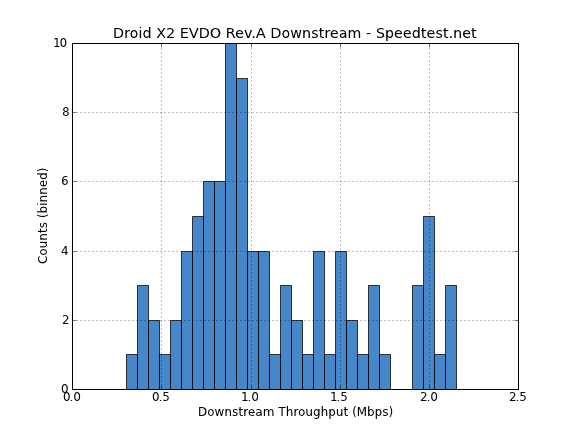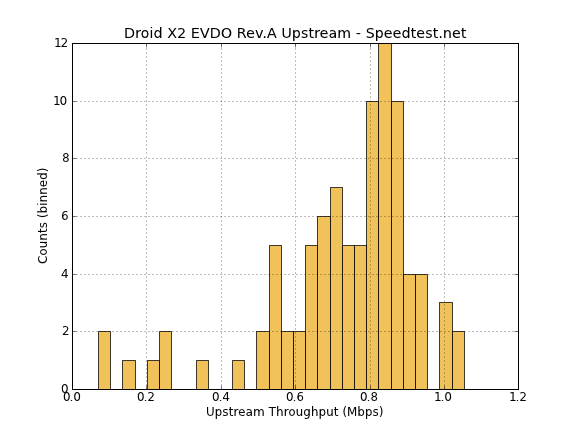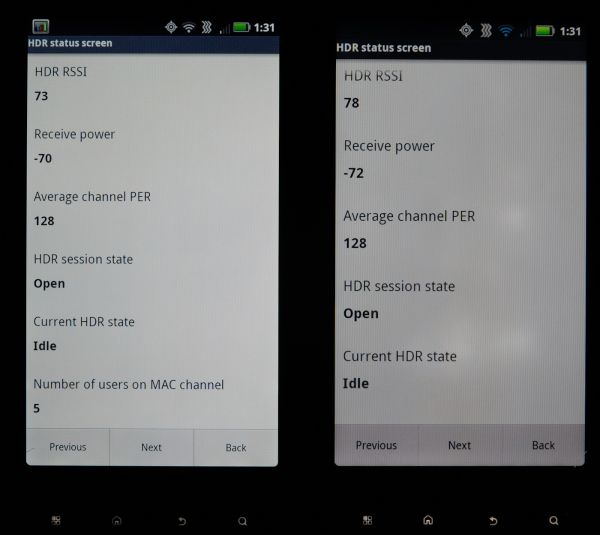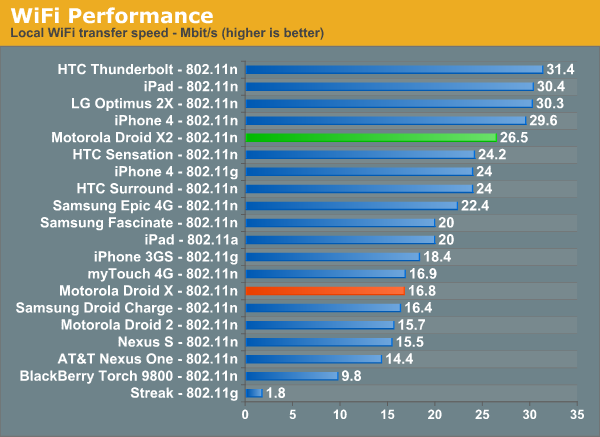Motorola Droid X2 Review - A Droid X with Tegra 2
by Brian Klug on July 7, 2011 8:31 AM ESTWiFi and Cellular Connectivity
The X2’s included cellular connectivity is the standard fare for Verizon in the USA. That means 800 / 1900 MHz 1x and EVDO Rev.A for the cellular side supplied courtesy a Qualcomm MDM6600. There's no GSM or UMTS connectivity for if you travel abroad. As a refresher, the Droid X used a Qualcomm QSC6085. I think the X2 hasn’t seen as much attention as its predecessor primarily because it doesn’t include any LTE connectivity. On the brighter side, you get better battery life as a result.



I ran just shy of 100 speedtests on the X2 and created histograms as always. Let me just say that it’s hard coming down off of LTE’s order of magnitude faster performance to EVDO Rev.A, seriously. Downstream performance is between 0.5 and 2 Mbps, about what I’m used to seeing for Verizon’s EVDO Rev.A network. Upstream is centered around an admittedly fast 0.8 Mbps. Latency has a bunch of erroneous results clustered down in the single digit ms response times which are just the speedtest.net application glitching out for some reason.
I neglected to put the X2 through our attenuation test suite, but again the device has receive diversity with cellular antennas at the top and bottom of the handset and should perform just as well as the first device. Likewise I didn’t notice any unwarranted drops in signal while using the handset and holding it. Over in field test (##program followed by 000000), the X2 reported signal usually within 1-2 dBm of the original Droid X.
 Left: Droid X2, Right: Droid X
Left: Droid X2, Right: Droid X
If you’ve been reading any of our smartphone reviews, you should be able to guess what WLAN and BT chipset is inside the Droid X2. Yes, it’s another smartphone with Broadcom’s BCM4329 combo chip, which means it has 802.11n single stream support on 2.4 GHz.

Performance is pretty speedy on our WiFi transfer test which consists of a 100 MB PDF being downloaded from a local server. WiFi range is also virtually unchanged from the Droid X, again I walked around my house with RSSI visible and watched the X and X2 sit within 1-2 dBm of each other, odds are it's the same antenna inside.

Things have indubitably sped up in part due to the X2's WLAN stack giving the 72 Mbps short guard interval rate instead of 65 Mbps long guard interval 802.11n speeds on the X.










72 Comments
View All Comments
NeoteriX - Thursday, July 7, 2011 - link
Again, the N8 is an unfair comparison, it's not even the same class of camera phone. Just like the other examples I cited, the Sony C-902, Nokia N82... these are cameras that happen to also be phones. The problem is that these are not apples to apples comparisons.The sensor on the N8 is 1/1.83″ -- by way of comparison, the Canon S95, a real point and shoot camera with very well-respected low light performance relative to its peers has only a slightly larger sensor of 1/1.7" Not to mention it has carl zeiss branded optics and a xenon flash (like the other examples I cited)
The iPhone 4 uses a mobile camera sensor of 1/3.2" and so does the HTC sensation.
Now I'm all for big sensors in cameraphones--the better the image quality the better, as the best camera is ultimately the one you take with you. And the N8 shows that you can shove real point and shoot sensors into a phone, but let's face the reality -- the market of phones with REAL camera sensors and optics is a very, very, very small niche market (they cost $$$ to put in those sensors) and doesn't reflect the mass market of advanced smartphones.
Again, the iPhone 4 represents the best candidate of this balance, and I'm really hoping others HTC, Motorola, etc. step up their game here, but I don't plan on owning an Apple device in the near future.
munky - Thursday, July 7, 2011 - link
It's a valid comparison, the N8 is a smartphone like all the others you mentioned, in the same form factor. I'm not comparing something the size of a DSLR to something that fits in your pocket.Yes, it has a bigger sensor, just like the S95 has a bigger sensor than average pocket cameras - does that mean the S95 is not qualified to be the gold standard of pocket cameras? Doing so is just a refusal to acknowledge a superior product in favor of the lowest common denominator.
NeoteriX - Thursday, July 7, 2011 - link
I agree, but I think the distinguishing factor is that the S95 performs better than anything in its class by any dimension.The large sensor camera phones are still a "niche" in the sense that you have to singularly want exceptional photographic performance to buy one of these phones -- and in return, you have to make several compromises as to the user interface, CPU performance/technology, software ecosystem, etc. The phones are geared towards an audience willing to deal with that.
However, if you look at the other major powers in the phone OS ecosystems (iOS, Win7, Android, WebOS?), none incorporate the large sensor into any phone, much less the kind of flagship phone that you would expect them to pull all the stops out for.
Believe me when I say I would go out and immediately buy the first Android phone with all the furnishings -- dualcore CPU, etc. that *also* included a large sensor and quality glass.
Exodite - Thursday, July 7, 2011 - link
That's a bit of a red herring considering that the vast majority of these so-called 'camera phones' aren't lacking in other desirable features.Indeed, a good camera is becoming something of a hallmark of high-end smartphones in general, HTC being the exception to the rule.
As for the cost you mentioned before, the N8 - undeniably the best-equipped smartphone today when the camera is concerned - is a mid-range phone.
Brian Klug - Thursday, July 7, 2011 - link
I'm a huge optics nerd (it's what I studied in college at least) so I always try and find out everything I can about the cameras in here. Usually that ends up being very little because it either isn't documented, or there's no information in the place I look.For the sensor type, it's easy enough to just run dmesg and scan through there. HTC lately has been initializing the camera and leaving the part number right there. I searched through on the X2 and couldn't find any camera sensor part numbers even in the sections where they're clearly starting to init the camera. It's unfortunate, because otherwise we could get a better feel for what sensors are usually very good and which ones usually aren't.
It's interesting that Apple did such a good job marketing backside illumination with the iPhone 4, when essentially every sensor at or over 8 MP needs to be backside illuminated (and thinned) due to skew effects. That said their camera is indeed very good.
-Brian
jamyryals - Thursday, July 7, 2011 - link
Love the video review format. My favorite smart phone reviewer on the net, keep it up Brian.munky - Thursday, July 7, 2011 - link
Why do the graphs always compare the usual Samsung and Motorolla phones, the old practically irrelevant iphone 3gs, Nexus One and Dell Streak, but not more variety of modern phones, like the Nokia N8, for example? Instead of grouping tablets and phones in the same graphs, separate the two categories so that each one has a better selection of relevant entries.Exodite - Thursday, July 7, 2011 - link
Regarding Motorala and their use of FWVGA over WVGA, they're not the only Android handset manufacturer who went that route as Sony-Ericsson also uses FWVGA on the X10/arc/neo/play.BryanC - Thursday, July 7, 2011 - link
I might consider buying this phone if not for the terrible pentile screen door effect, which is simply unacceptable in today's day and age.The iPhone4 has 960x640x3 subpixels in 5.65in2 area. The Droid X2 has 960x540x2 subpixels in 7.90in2 area. The iPhone has 2.5X the subpixel density of the Droid X2! And it's immediately obvious when you look at the displays - the iPhone4 display is so detailed the image looks printed on, it's in a completely different class.
Too bad.
JayQ330 - Thursday, September 1, 2011 - link
what does that have to do with any of this? oh i see, wipe your chin there's still some iphone honey left.